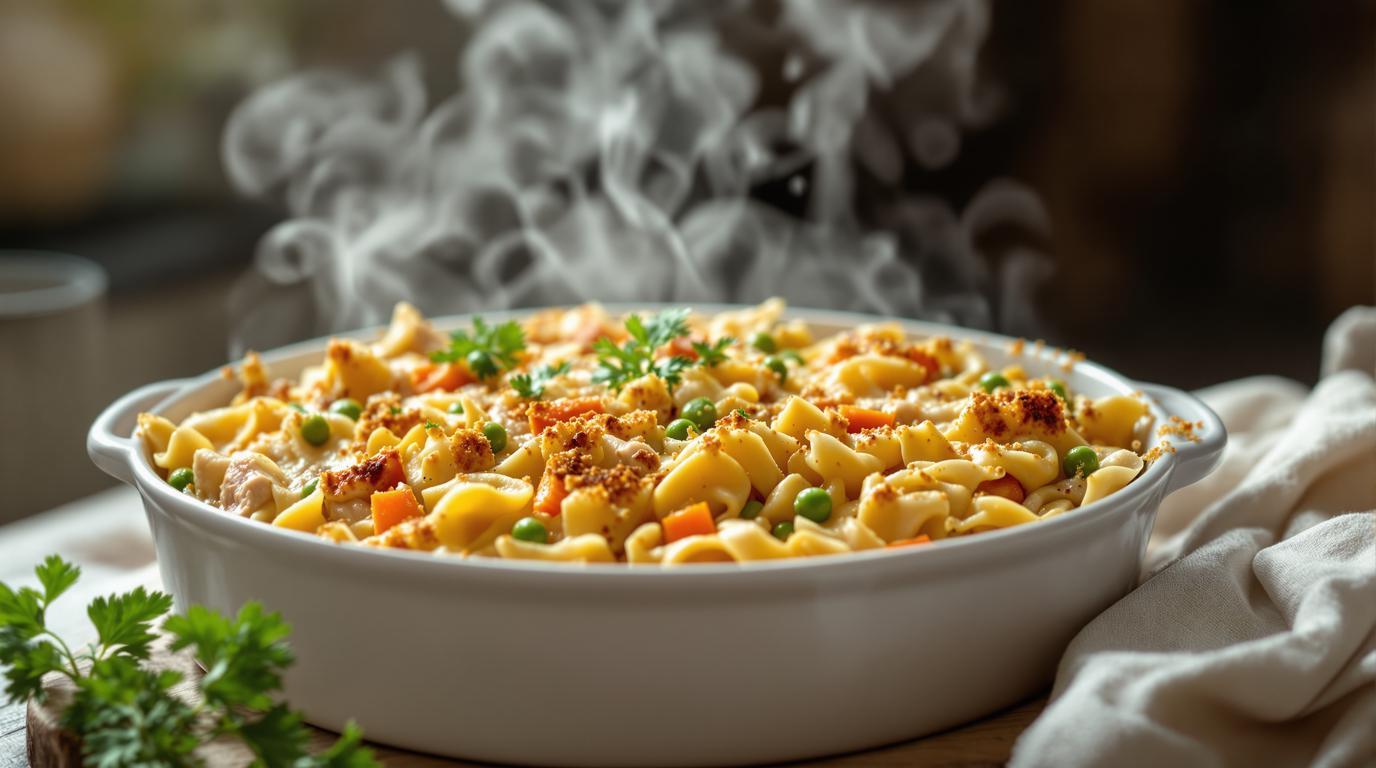Growing up in New England, tuna noodle casserole was a staple in our home, especially during the cooler months when my mother would pull out her trusty casserole dish. What most people don’t realize is that this humble American classic actually gained popularity in the 1950s during a perfect storm of canned food availability and busy post-war households. Today, I’m sharing my grandmother’s recipe with a healthful makeover that preserves all the nostalgic comfort while incorporating modern nutritional wisdom. The secret? A silky homemade sauce that replaces canned soup entirely—trust me, you’ll never go back! 🍽️
Reimagining a Comfort Food Classic 🌟
My grandmother’s tuna casserole recipe card is worn at the edges, spotted with decades of splattered sauce—a testament to how frequently it appeared on our family table. While I cherish the original, my professional training has taught me that we can honor traditional flavors while upgrading the nutritional profile. This version swaps processed ingredients for whole foods without sacrificing an ounce of that creamy, savory goodness you remember.
The Building Blocks of a Better Casserole 🧱
For the base:
• 8 oz (225g) whole grain egg noodles
• 2 cans (5 oz/142g each) water-packed tuna, drained
• 1 cup (150g) frozen peas
• ½ cup (65g) diced carrots
• ½ cup (50g) diced celery
• 1 small onion, finely chopped
For the creamy sauce:
• 2 Tbsp (28g) unsalted butter
• 2 Tbsp (16g) all-purpose flour
• 1 cup (240ml) whole milk
• ½ cup (120g) non-fat Greek yogurt
• ½ tsp garlic powder
• ¼ tsp black pepper
• 1 Tbsp fresh parsley, chopped
For the topping:
• ½ cup (56g) reduced-fat cheddar cheese, shredded
• ¼ cup (30g) whole grain breadcrumbs
The Method: Building Layers of Flavor 👨🍳
- Preheat your oven to 375°F (190°C) and bring a large pot of salted water to a boil.
- Cook the whole grain noodles until just al dente—about 2 minutes less than package directions. They’ll continue cooking in the oven, and nobody enjoys mushy pasta. Drain and set aside.
- In a heavy-bottomed skillet, melt 1 tablespoon of butter over medium heat. Add the onions, carrots, and celery, cooking until the vegetables begin to soften but still maintain some texture, about 5-6 minutes. The gentle caramelization here builds flavor foundation.
- For the sauce (pay attention here—this replaces canned soup entirely): In a separate saucepan, melt the remaining tablespoon of butter over medium heat. Sprinkle in the flour and whisk continuously for about 60 seconds. This roux should smell slightly nutty but not brown.
- Gradually whisk in the milk, ensuring no lumps form. This is classic French technique at its most practical. Bring to a gentle simmer, whisking until the sauce thickens enough to coat the back of a spoon, about 3-4 minutes.
- Remove from heat and stir in the Greek yogurt, garlic powder, black pepper, and chopped parsley. The yogurt provides protein and tangy depth that beautifully mimics the richness of mayonnaise or sour cream.
- In a large mixing bowl, gently combine the cooked noodles, sautéed vegetables, drained tuna, and frozen peas. Pour the creamy sauce over everything and fold gently until evenly coated.
- Transfer to a lightly greased 9×13-inch baking dish. Top with the shredded cheese first, followed by an even sprinkling of breadcrumbs.
- Bake for 25-30 minutes until the edges bubble and the top turns golden brown. Allow to rest for 5 minutes before serving.
Chef’s Note: The key to preventing a dry casserole is not overcooking your noodles and allowing the dish to rest after baking. This resting period lets the sauce settle and thicken to the perfect consistency while allowing the flavors to marry.
Thoughtful Substitutions & Variations 🔄
Can’t find whole grain egg noodles? Regular egg noodles work perfectly well, though you’ll lose some fiber. Dairy-free? Replace the milk with unsweetened almond milk and use dairy-free cheese. For extra vegetables, add a handful of spinach or sliced mushrooms when sautéing the vegetables.
This updated classic pairs beautifully with a simple honey balsamic salad or a glass of Southern-style iced tea. For protein enthusiasts, this dish complements my high-protein overnight oats for a balanced day of eating.
Looking for something to nibble while dinner bakes? Try my spicy frozen grape snack or Mediterranean tuna bean salad to tide you over.
What I love most about this modernized casserole is how it honors tradition while embracing nutritional wisdom. At approximately 350 calories per serving with 25g of protein and 5g of fiber, it offers substantially more nutrition than its predecessor without sacrificing the creamy, comforting character that made it a beloved classic. In my kitchen, honoring culinary heritage never means we can’t make thoughtful improvements—I like to think Grandma would approve. After all, good cooking has always been about love, nourishment, and bringing people together around the table. 🍴❤️
